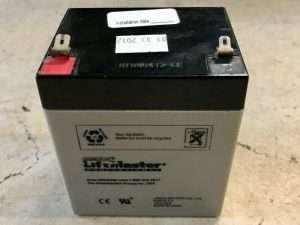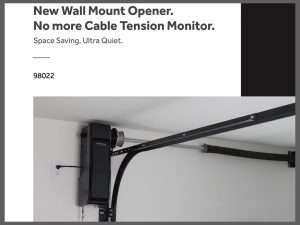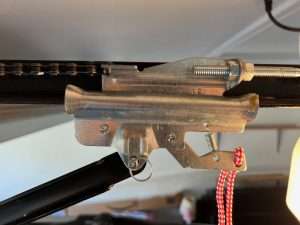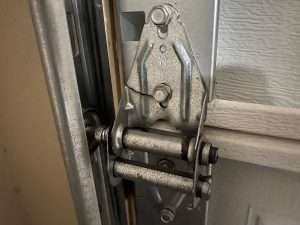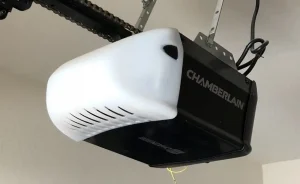How to Secure a Garage Door
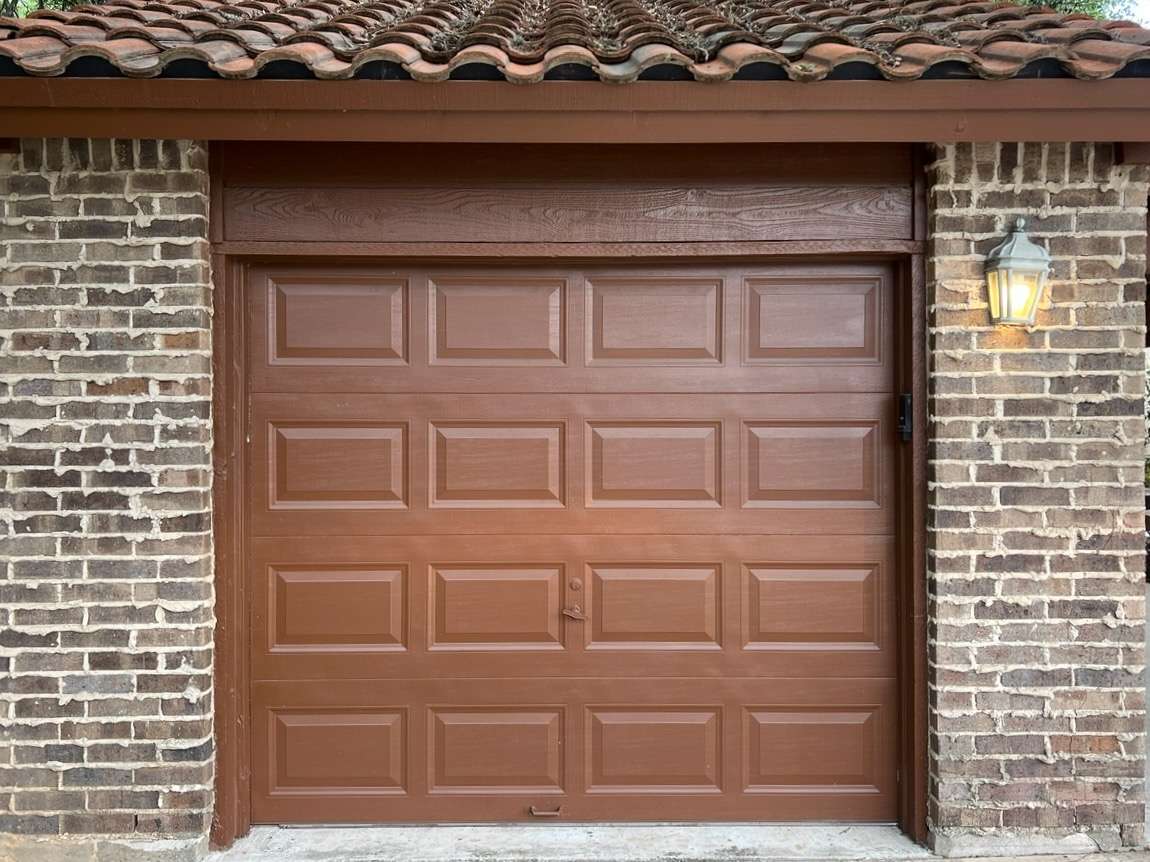
Working daily repairing residential garage doors has given us a different perspective, and it keeps our ear to the ground. We know which questions homeowners are asking and what gives them anxiety when it comes to securing their garage door.
In this article, we will clear the air about garage door security and answer two of the most common questions:
- How do you manually lock a garage door?
- How do you secure a garage door during a power outage?
But, let’s first start with the most obvious question.
How Secure are Garage Doors?
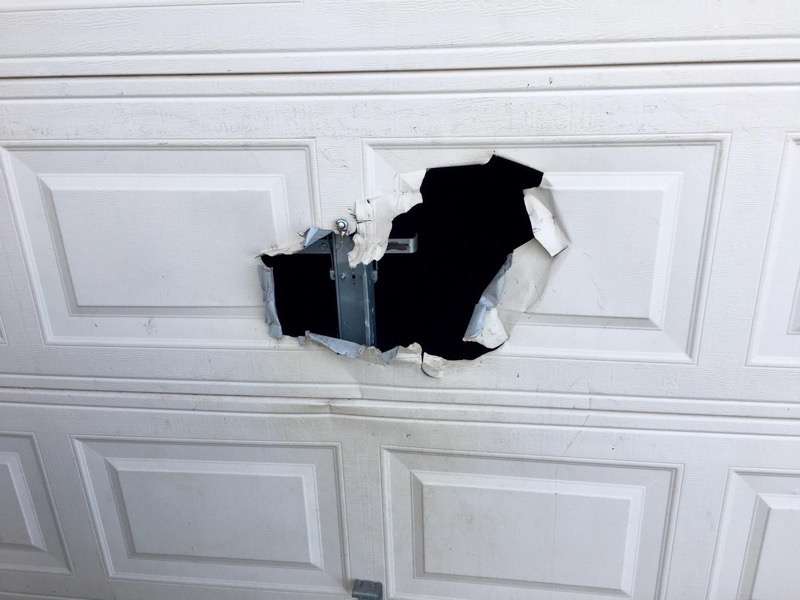
Contrary to popular belief, garage doors are not usually the most popular entry point into a home by an intruder. Since most garage doors face the street, a burglar is highly exposed when trying to break into a garage. Combined with the fact that most garage doors are hollow metal, they can be very noisy if someone is trying to penetrate. With that being said, a garage door would be harder to break through than a door or window.

If you are looking for the strongest garage door, make sure to have a two-inch thick steel back insulated door installed when you’re in the market for a new door. A steel back insulated garage door is also referred to as a triple layer door. It features the outside layer of metal, insulation in between, and a layer of metal on the inside which essentially sandwiches the insulation in between.
Standard insulation on a steel back insulated garage door is the white polystyrene foam. If you’re looking for the strongest option, go for the polyurethane spray-in yellow foam, which is essentially much stiffer, and it provides a greater insulating value. Just don’t be surprised when you see the cost to upgrade, as a quality garage door can be quite pricey these days.
Full Struts on Your Garage Door
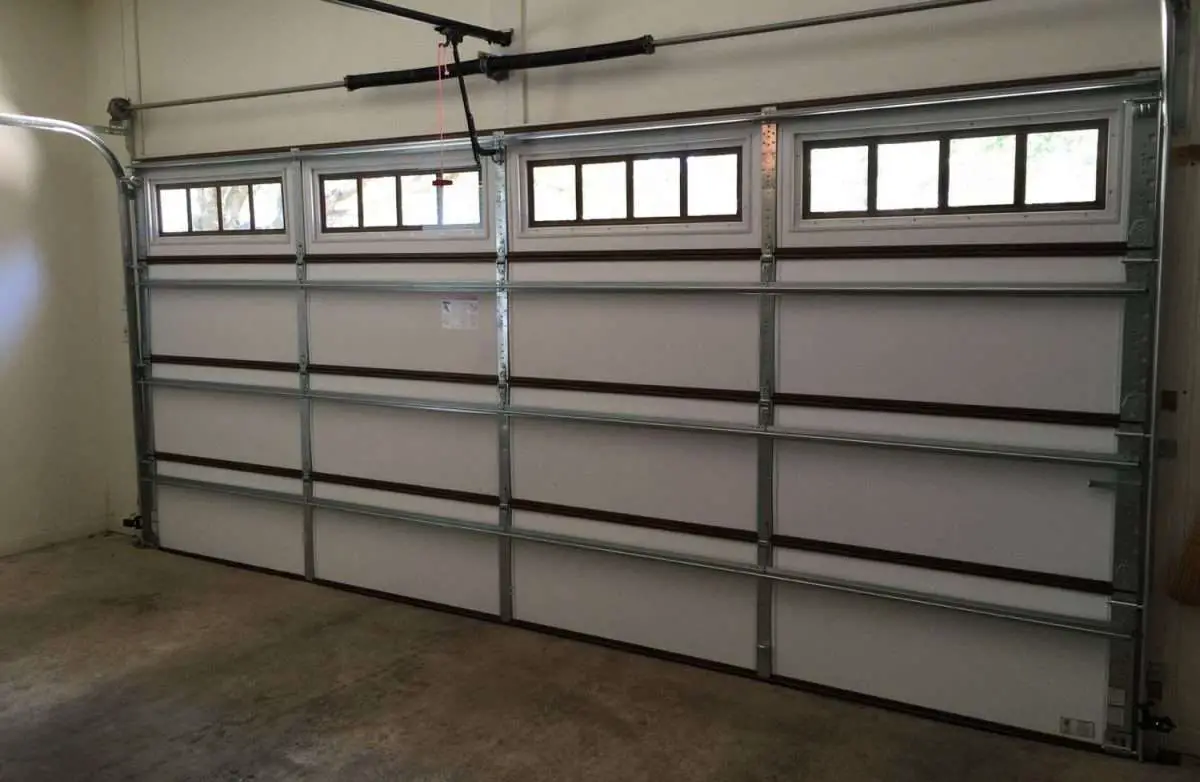
If you want the strongest garage door, whether you are opting for non-insulated or insulated, order your new garage door with full struts. A typical 16ft wide by 7ft tall garage door comes standard with a top strut on the top section. Ordering a garage door with full struts will put one reinforcement strut on each section, for a total of four struts. This will drastically stiffen up each section and add years of life to your garage door section. Not to mention, it will make it harder for someone to break through a section with a reinforcement bar running across.
How to Manually Close a Garage Door During a Power Outage
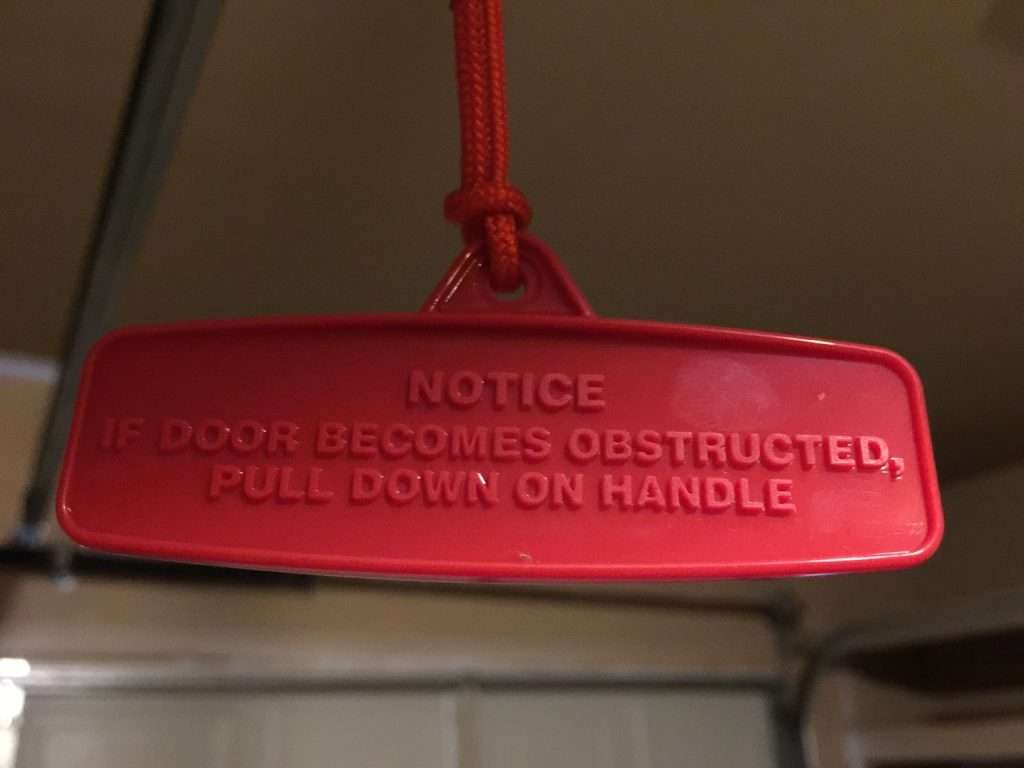
If the power goes out in your home and you need to manually close your garage door, look for the red rope hanging from your garage door opener rail. This rope is usually tied on the carriage release lever which allows you to disconnect your automatic opener from your garage door.
Most people think this red rope is only used to disconnect and open your garage door, but closing your door is just as important when the power goes out or if your garage door opener stops working altogether.
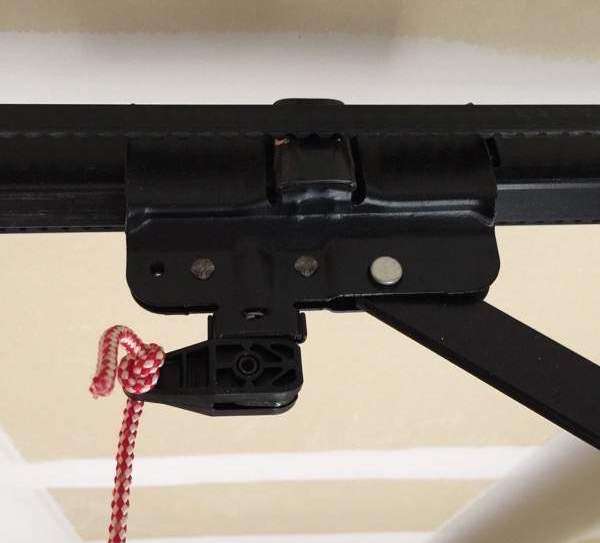
If you don’t see a red rope hanging, then it either broke off or someone removed it. At that point you want to look at the area where the black pick up arm attaches to the opener rail. The pick up arm attaches to the opener carriage which will have a release lever you can pull down. This will disconnect the opener carriage from the inner slide on the rail allowing you to open or close your garage door.
Can Someone Open My Garage Door From the Outside?
I hate to break it to you, but if someone wanted to get into the average home, it’s not that hard. All they have to do is kick in the front door or break a window. Now, because the local news has broadcasted stories for years telling homeowners that someone is scanning their remote frequency, many fear that someone can access their garage door from the outside. Could this happen? Sure. Does it happen regularly like they want you to believe? No.
Rolling Code Technology
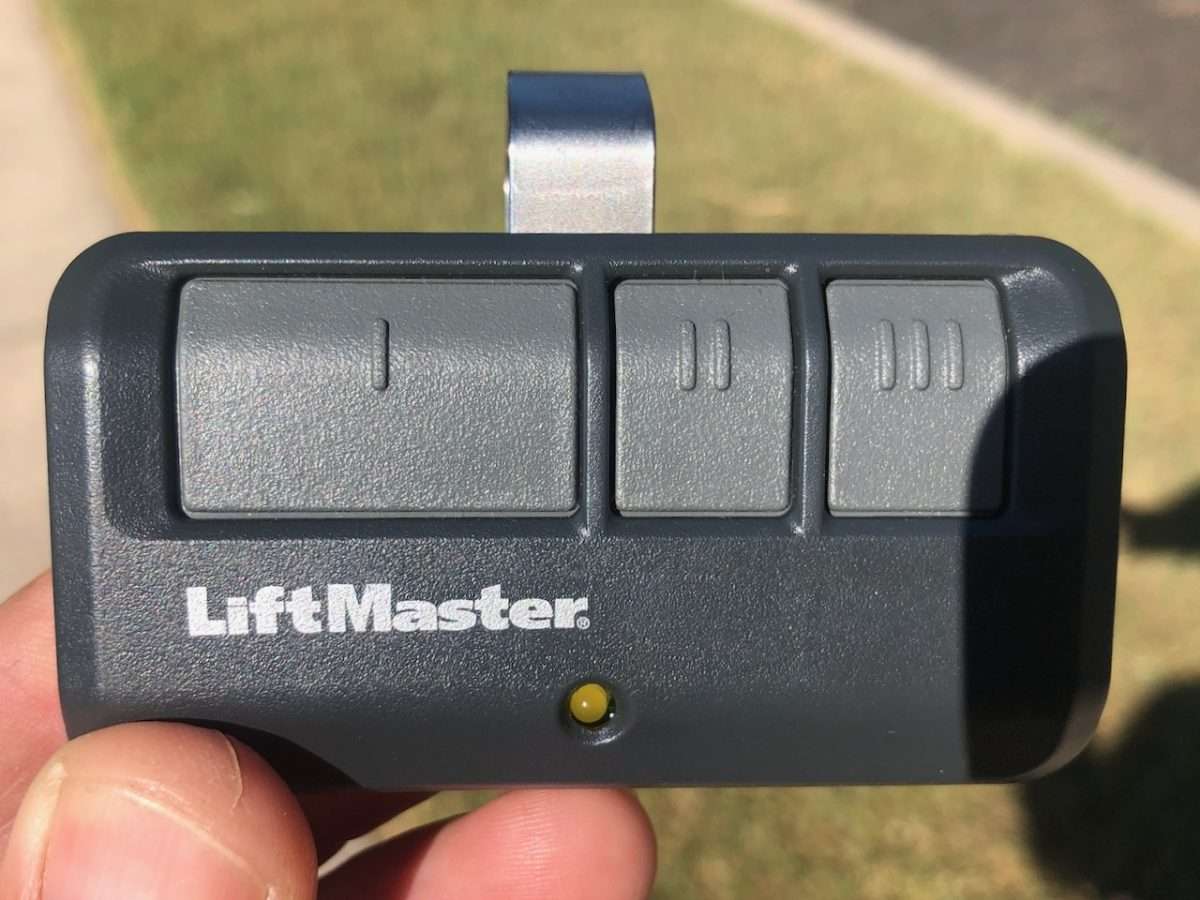
Newer garage door openers today use a rolling code technology that prevents anyone from scanning frequencies and opening garage doors. Here is a direct quote from the Chamberlain website explaining how rolling code technology works.
When the remote control activates the garage door opener, a unique algorithm “rolls” the remote control’s code to one of more than 100 billion possible codes. The previously used code will be discarded, and the opener will only to respond to the new code the next time the remote control is used. The same code will never be used more than once. Stolen codes are useless to intruders.
Because modern-day remotes use unique identifiers and rolling code technology is incorporated, gone are the days of someone stealing your garage door remote code.
Red Emergency Release Rope
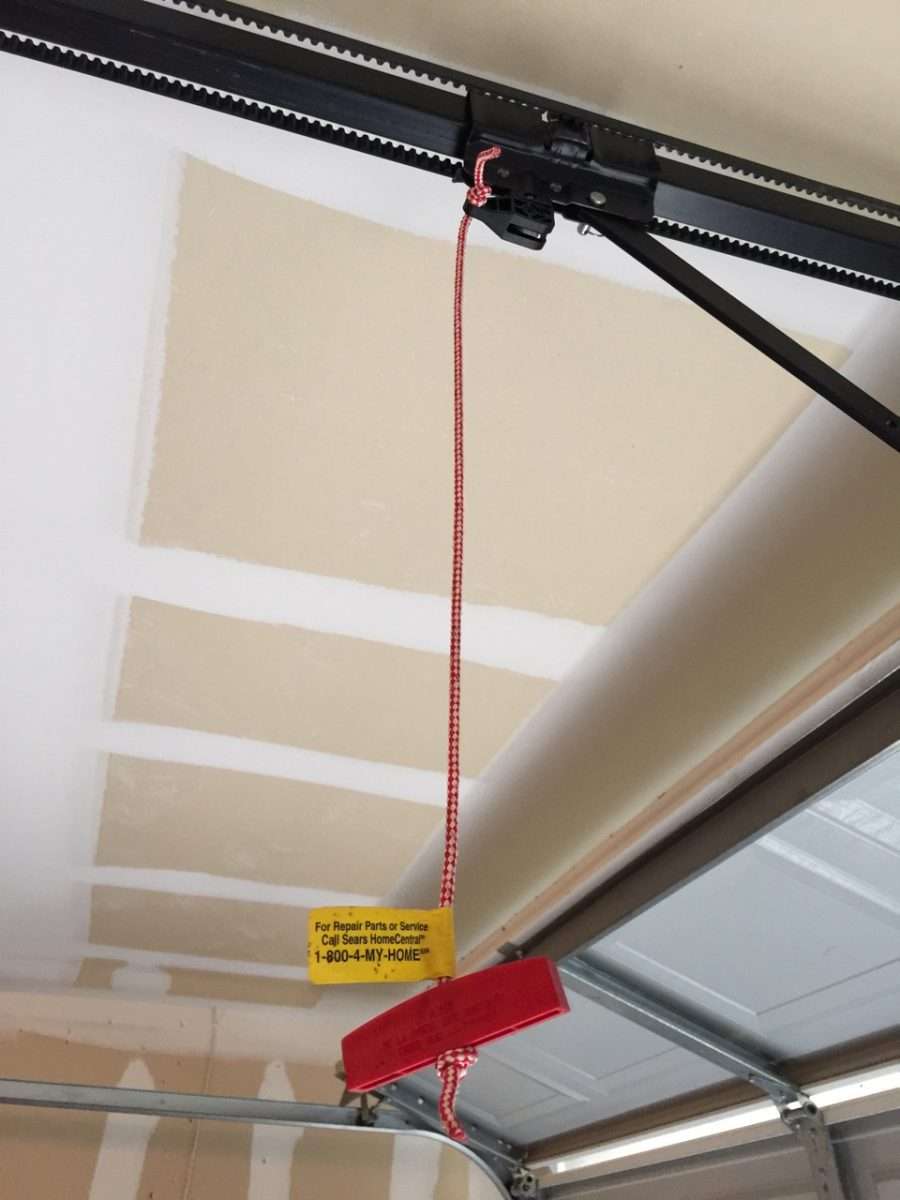
Going back to local news stations, they have a tendency to run stories that often give bad advice. One particular story recommended for homeowners to disable their emergency release rope by installing a cable tie. The reason for this is they said burglars were accessing garages by phishing a wire up in between the top garage door section and the header and pulling the red rope.
While this can be accomplished, it is not easy and it takes time. We have tried this many times and have failed to gain entry more times than we have succeeded. Especially if the opener pick-up arm is pushing the top section tight against the header. If that is the case, you won’t be able to phish the wire.
We DO NOT recommend installing a cable or zip tie to disable the carriage on your garage door opener. This sounds like a great idea. But, if a fire were to push members of your family to the garage, so they can exit the home, they will need the ability to pull the red rope to release the door from the opener. While you may be strong enough to pull the red rope and break a cable tie, other members of your family may not have that same strength.
Often, a fire can knock out the electricity to a home, therefore leaving the red release rope as the last option for safely exiting the home.
How To Secure a Garage Door From the Outside
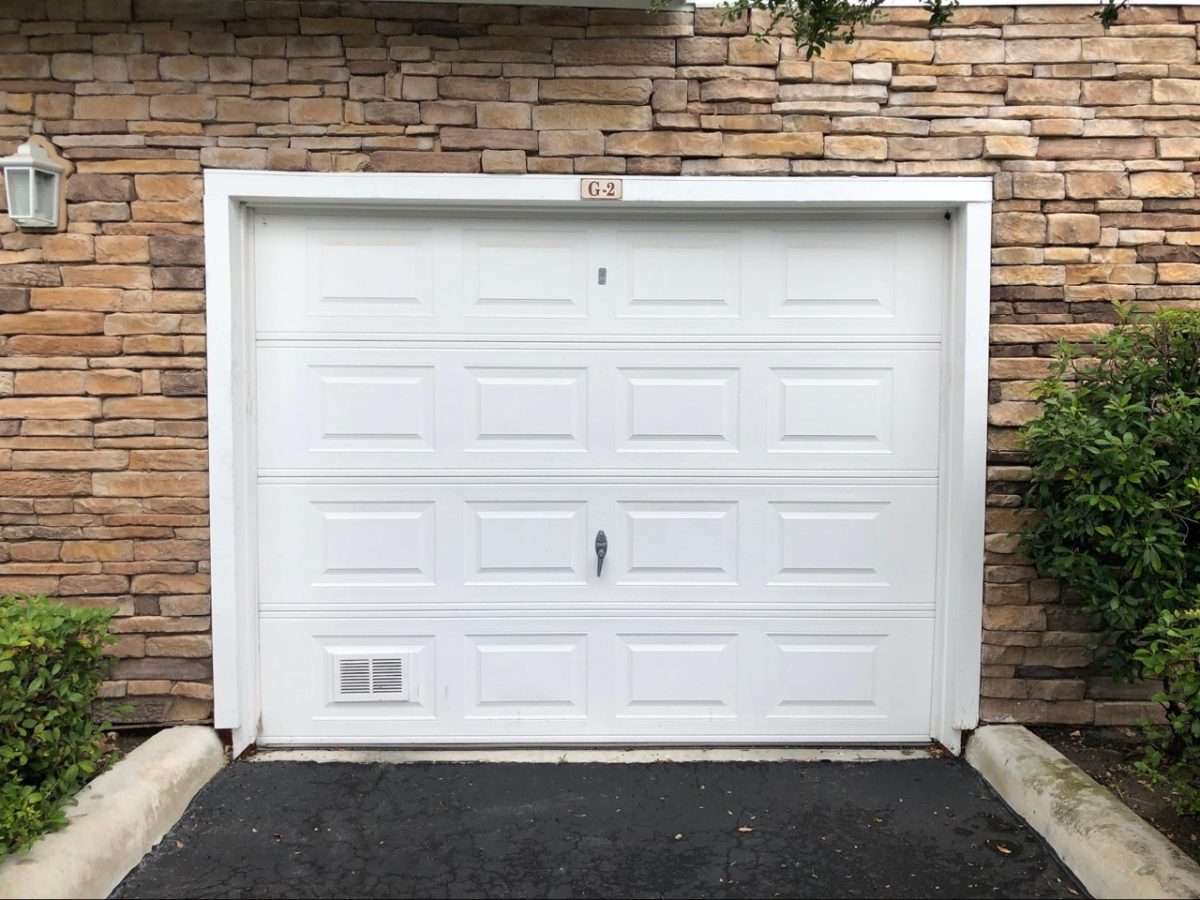
If you have an automatic opener installed on your garage door that you use daily, then there is no reason to secure your garage door on the outside. The opener pickup arm is locking the garage door in the down position. There are a few situations where removing outside access is warranted, or you may just want to be able to lock your door manually when leaving.
Lock Button on Garage Door Opener
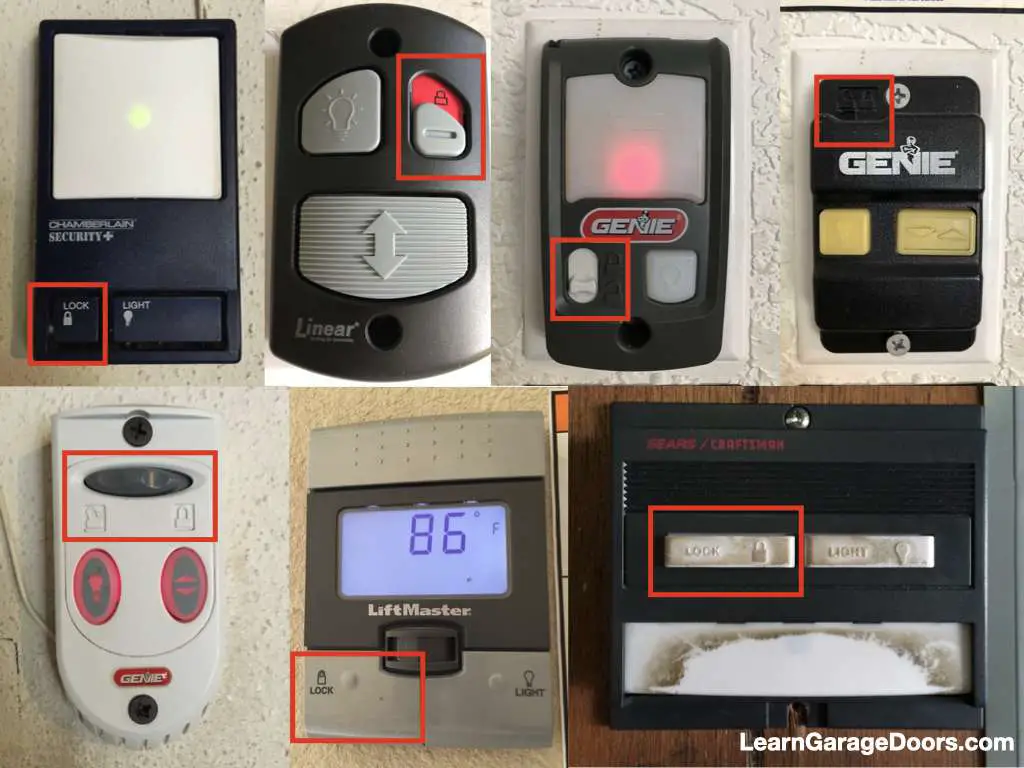
If you have an automatic opener installed on your garage door, and you want to block all remotes from opening the door, you can activate the lock on the wall button if your opener is equipped with this feature. Wall buttons equipped with vacations locks are considered to be a deluxe feature, and they normally come with a mid to higher priced opener.
Once this lock is activated on most brands, remotes will no longer open the garage door. Please keep in mind that the outside keypad will still work on some brands, while other brands disable that functionality as well.
Installing a Keyed Garage Door Lock
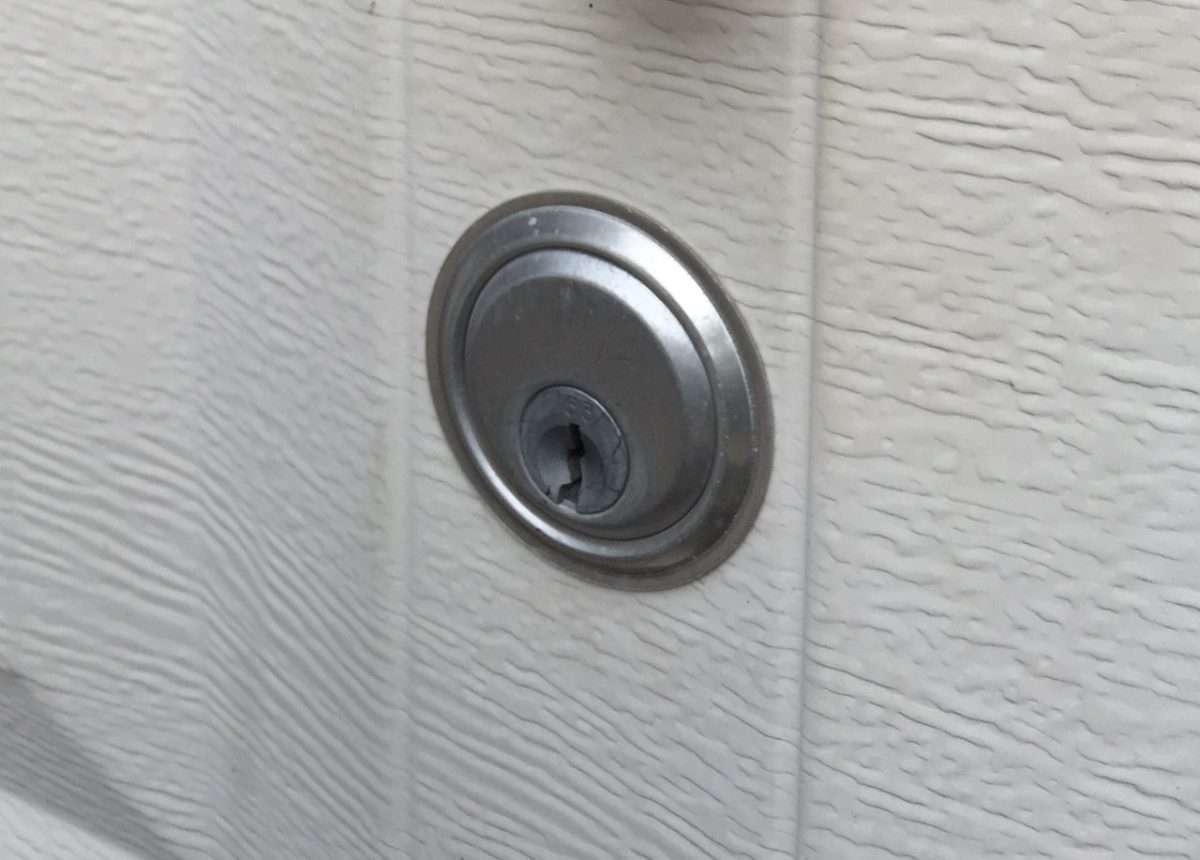
Installing a keyed garage door lock in a garage door is not easy. I don’t care what anyone says. Most garage door installers who were hired in recent years have no idea how to cut a lock into a garage door unless they were trained by an old timer.
If you need an outside keyed lock for your garage door, hire a garage door company. They will be able to source the correct lock for your specific model of door. This allows you to lock and unlock your garage door from the outside when accessing your garage.
Emergency Release Lock on Garage Door
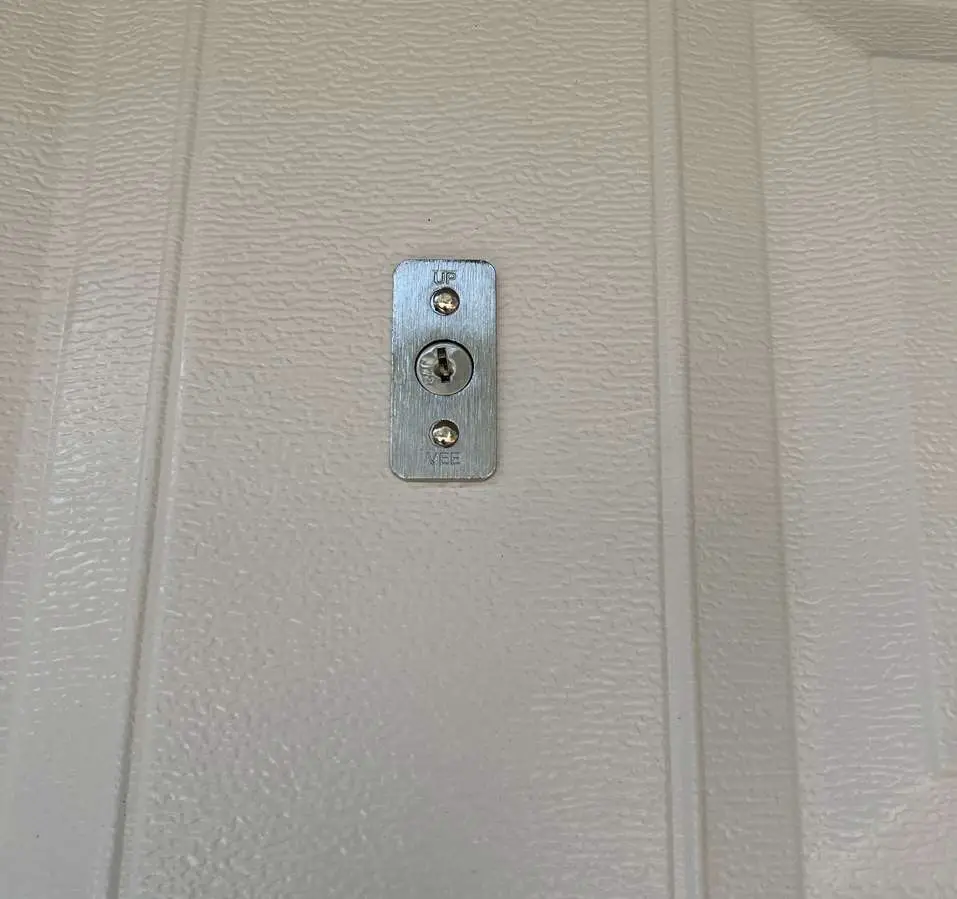
If you have a garage that can only be accessed through the garage door, you will most likely want to install an emergency release lock if you are using an automatic opener. This may not be something you use very often, but it will save you a lot of time and money when your opener has no power.
An emergency release lock has a cable attached to a lock that is installed in the top section of the garage door. When you insert your key to pull the barrel of the lock out, the cable will come out as well. You can then tug on it to release the carriage on the automatic opener, so you can gain access to the inside of the garage during a power outage.
How to Secure a Garage Door From the Inside

The inside slide lock and outside keyed lock with an internal night latch are the most common ways to secure a garage door from the inside. We will cover these two popular options along with many other ways to quickly secure a garage door from the inside, so you can have some peace of mind.
Interior Slide Lock
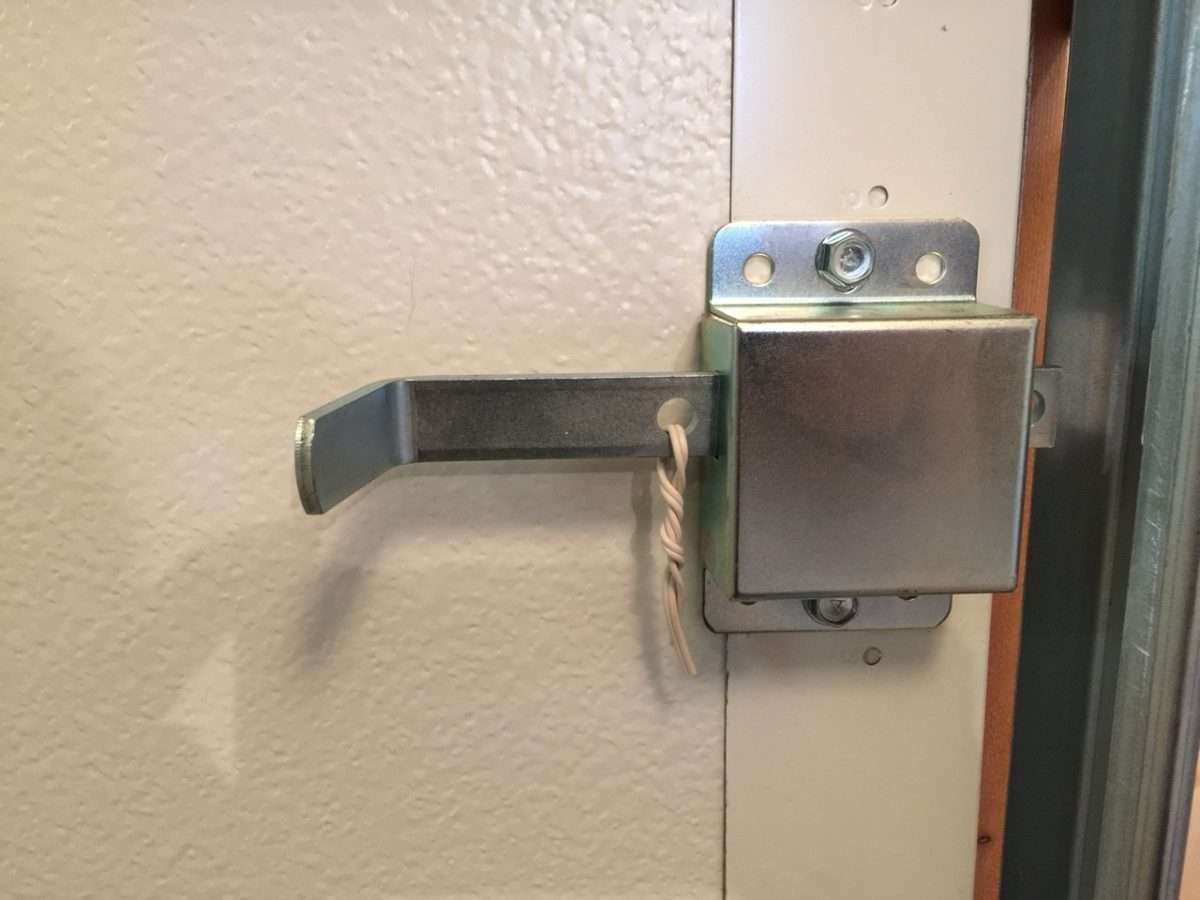
The interior slide lock will be the most common way to secure a garage door from the inside. They come standard on most garage doors and are located usually on the second section on the left or right-hand side. Most commonly found on the right side. This type of lock has a slide bolt that goes through a hole in the vertical track when the garage door is in the down position.
The inside slide lock on your garage door may be disabled if you have an automatic opener installed. This is common practice so no one accidentally locks the garage door and presses the remote or wall button to open the door. This can cause the garage door to go off track and damage the sections as well. Make sure your lock is disabled if you’re not using it to prevent this from happening to you.
Interior Slide Lock with Padlock
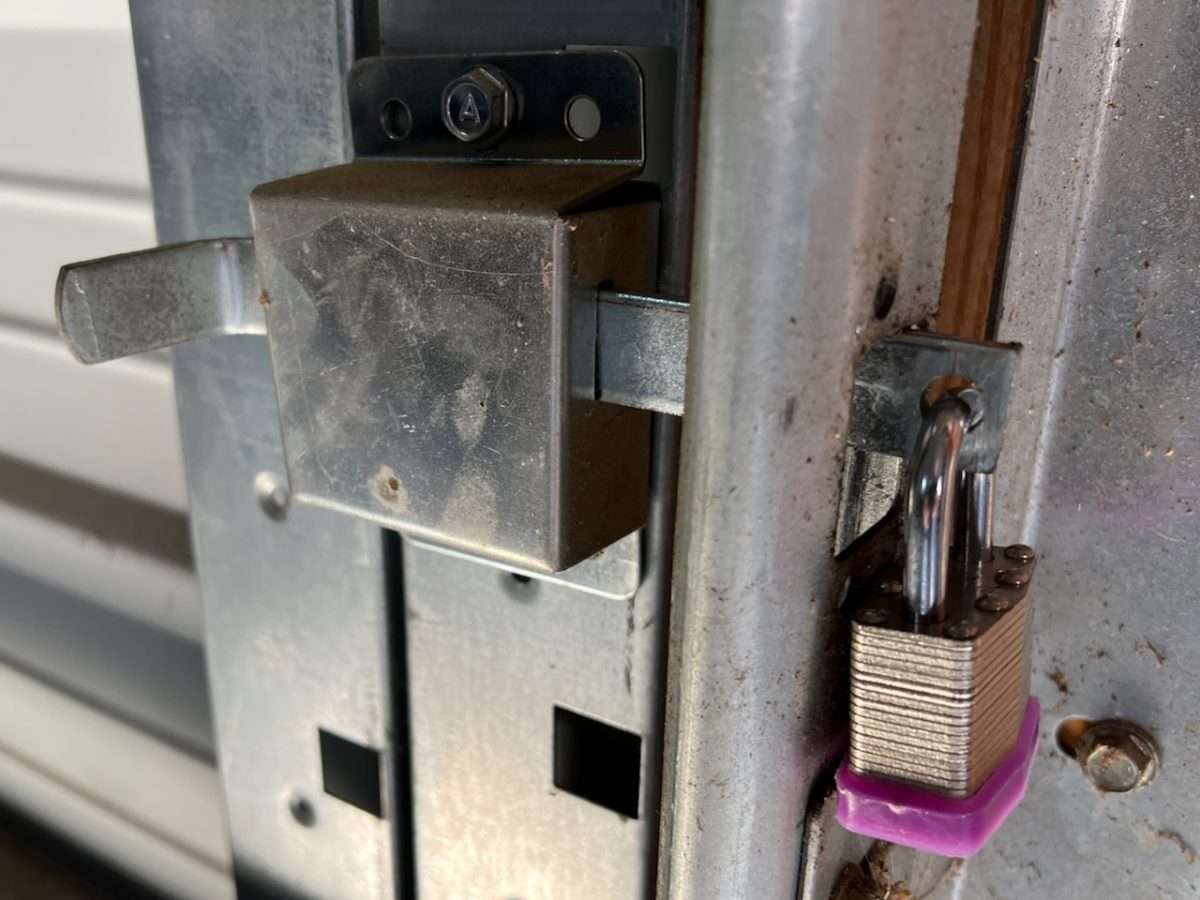
If you want to take security one step further when using the inside slide lock, you can install a padlock on the slide bar that goes through the track. If your slide lock doesn’t have a hole, you can drill one. This will prevent anyone who is visiting the home from opening the garage door at all. Please keep in mind, if someone on the inside of the garage wanted to remove the slide lock, it would be easy as there are only two screws attaching it to the garage door section.
Keyed Garage Door Lock
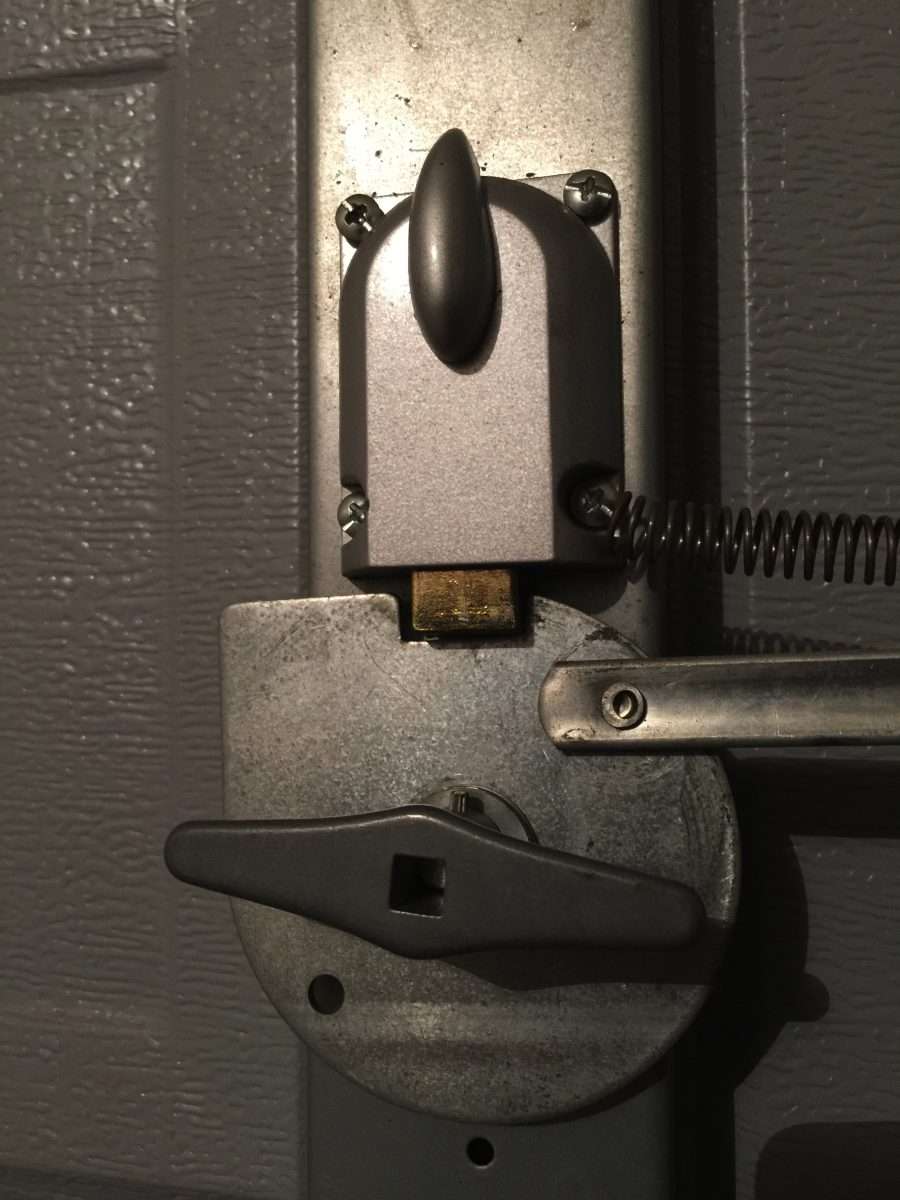
If your garage has an outside keyed lock installed, you most likely have a night latch on the inside. Once you twist the handle on the inside, so the lock bar goes through the track, a bolt will drop and engage to keep the door locked. The night latch lever should be in the vertical position like in the picture above. If the lever is turned to the left horizontally, that means it is disengaged, and it won’t lock.
Vise-Grips Clamped on Track
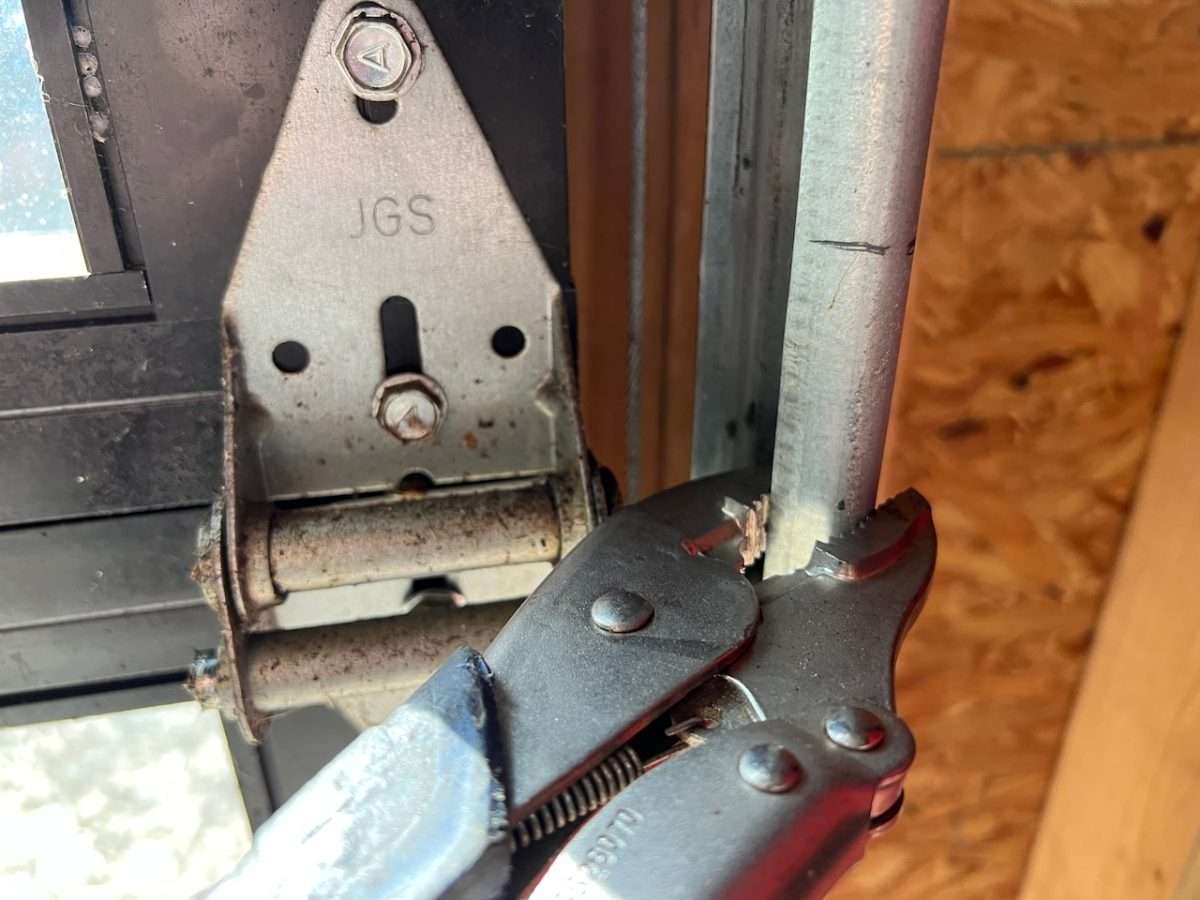
Something as simple as clamping Vise-Grips on a garage door vertical track is strong enough to secure a garage door in the down position. Vise-Grips are one of the most important tools used by a garage door technician, and they can be found in most toolboxes.
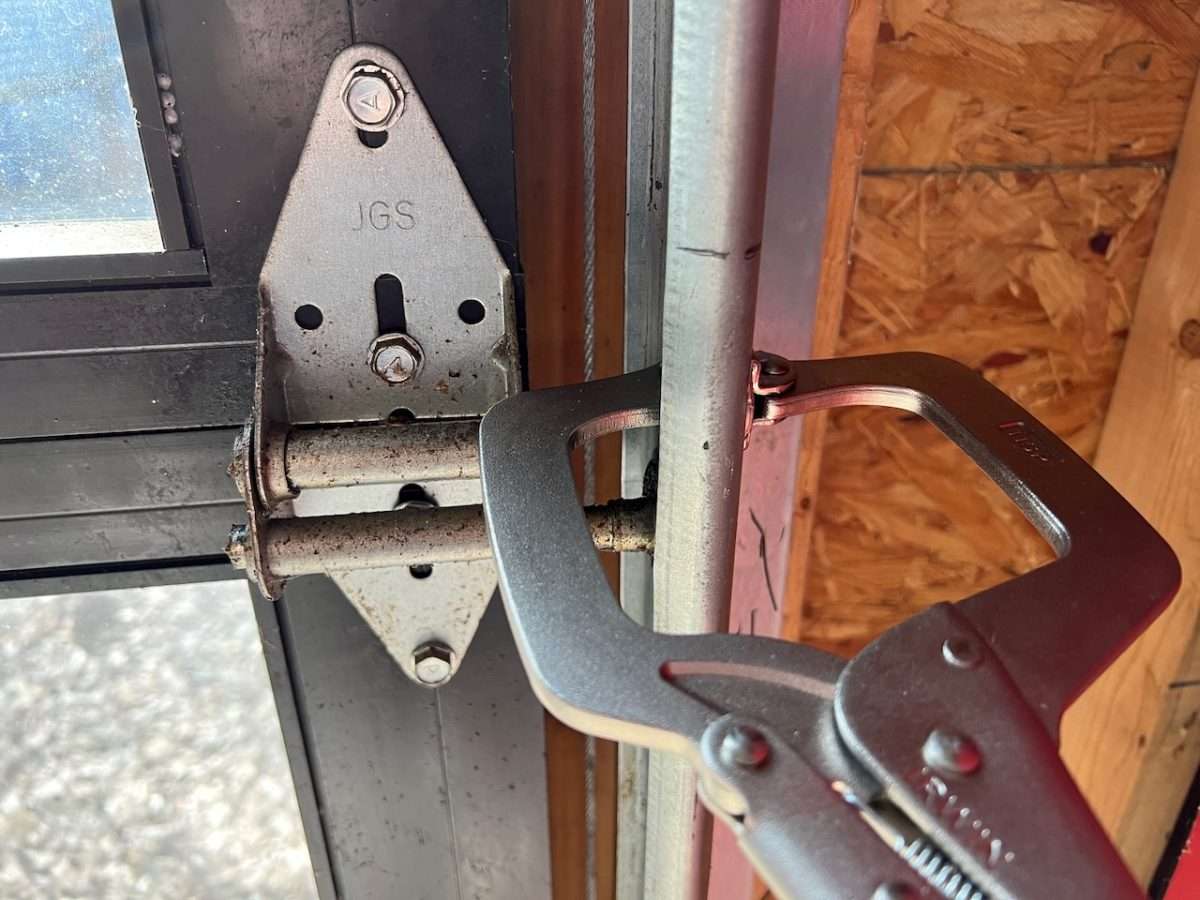
Clamping a pair right above one of the garage door rollers will keep someone on the outside from opening your garage door.
Screwdriver in Vertical Track
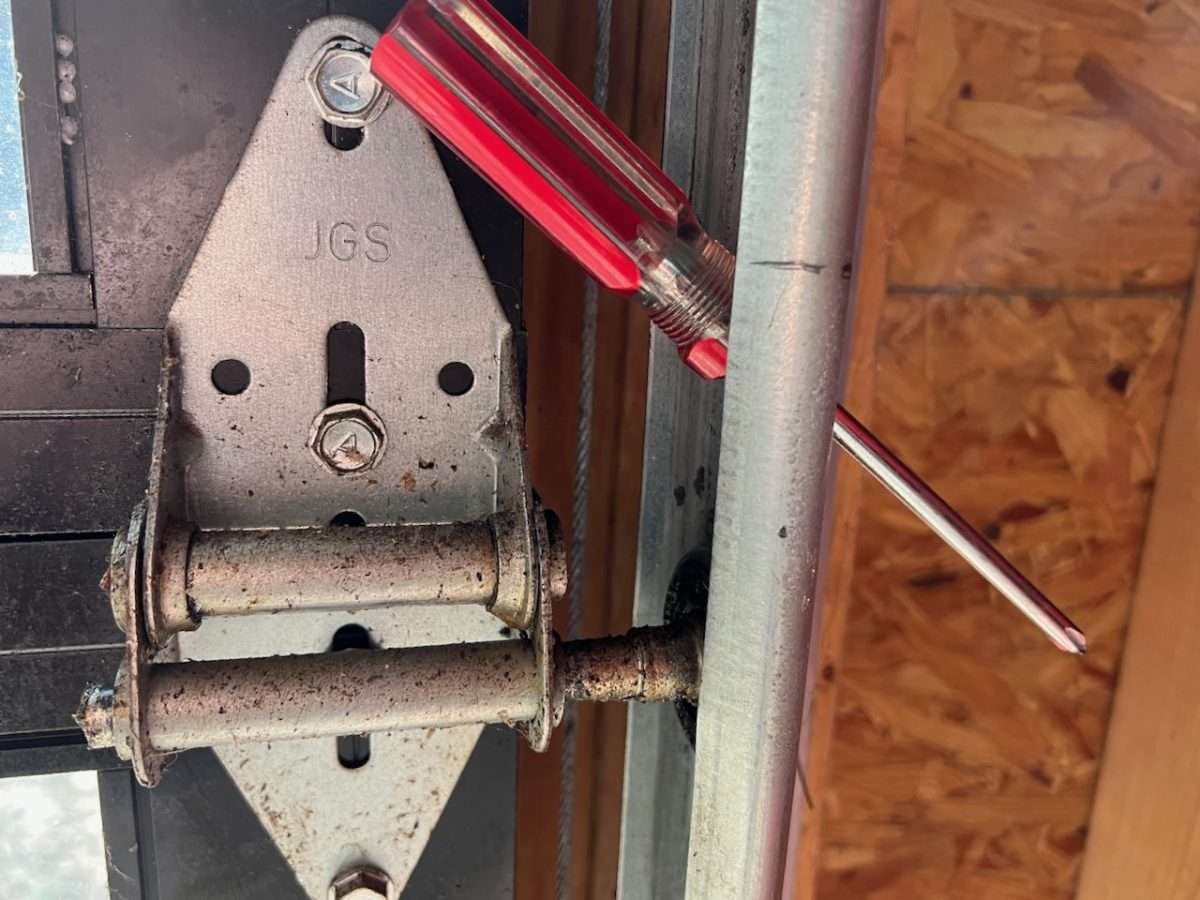
Sticking a screwdriver through a hole in the vertical track right above one of the garage door rollers will prevent someone from manually opening your garage door. Keep in mind, the screwdriver will have a tendency to fall out of the hole if the garage door is lifted, since the handle of the screwdriver is heavier than the shaft. A padlock is also a great option to stick through a whole in the vertical track for securing the garage door.
Wire, Cable Tie or Rope on Vertical Track
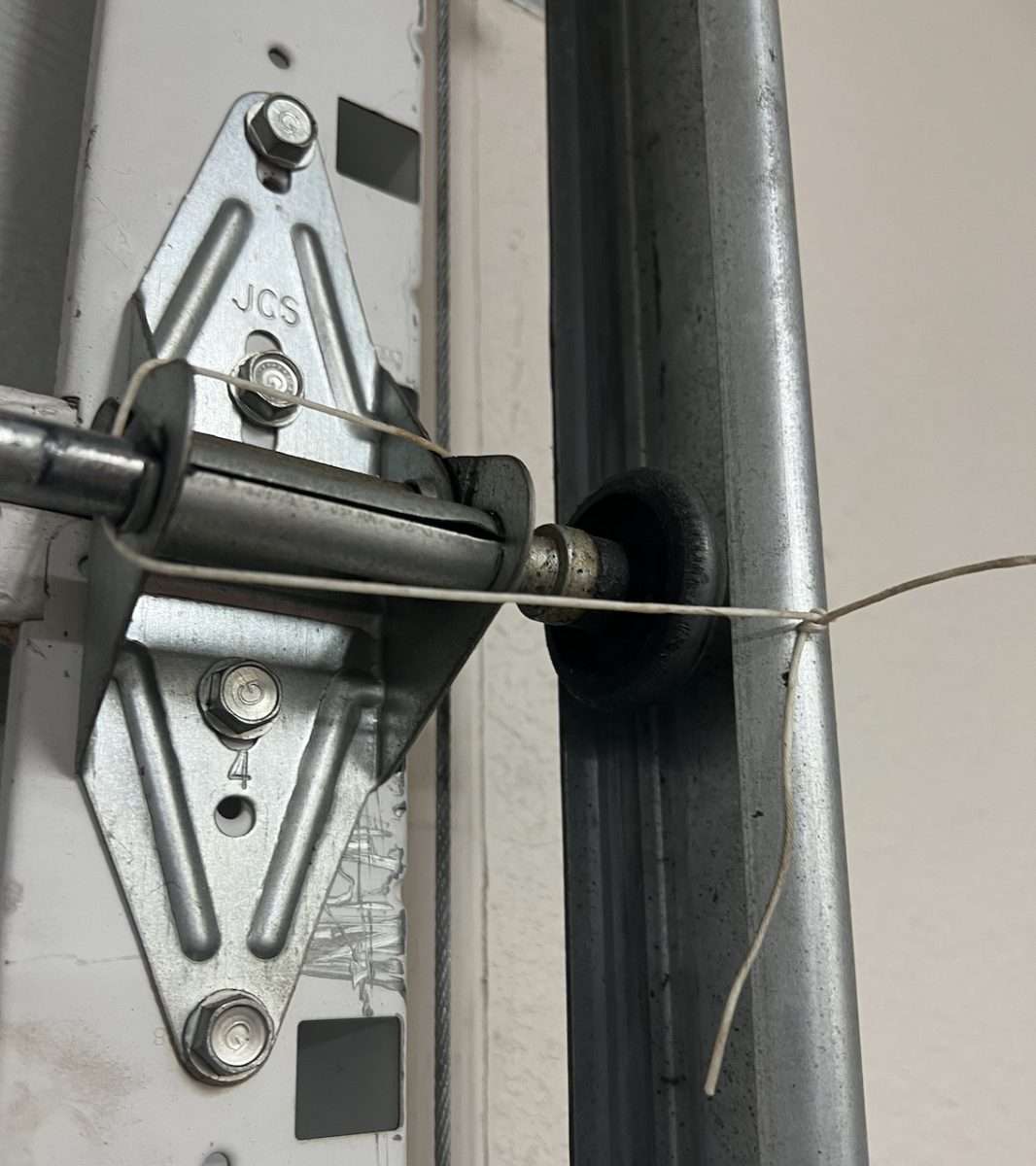
You can use wire, cable ties, or rope that is run through a hole in the vertical track to secure the garage door in the down position by tying it to one of the garage door hinges. This is one of the quickest ways to secure a garage door, so it can’t be opened. Even a metal clothes hanger works well for this task.
Clamp on Garage Door Track
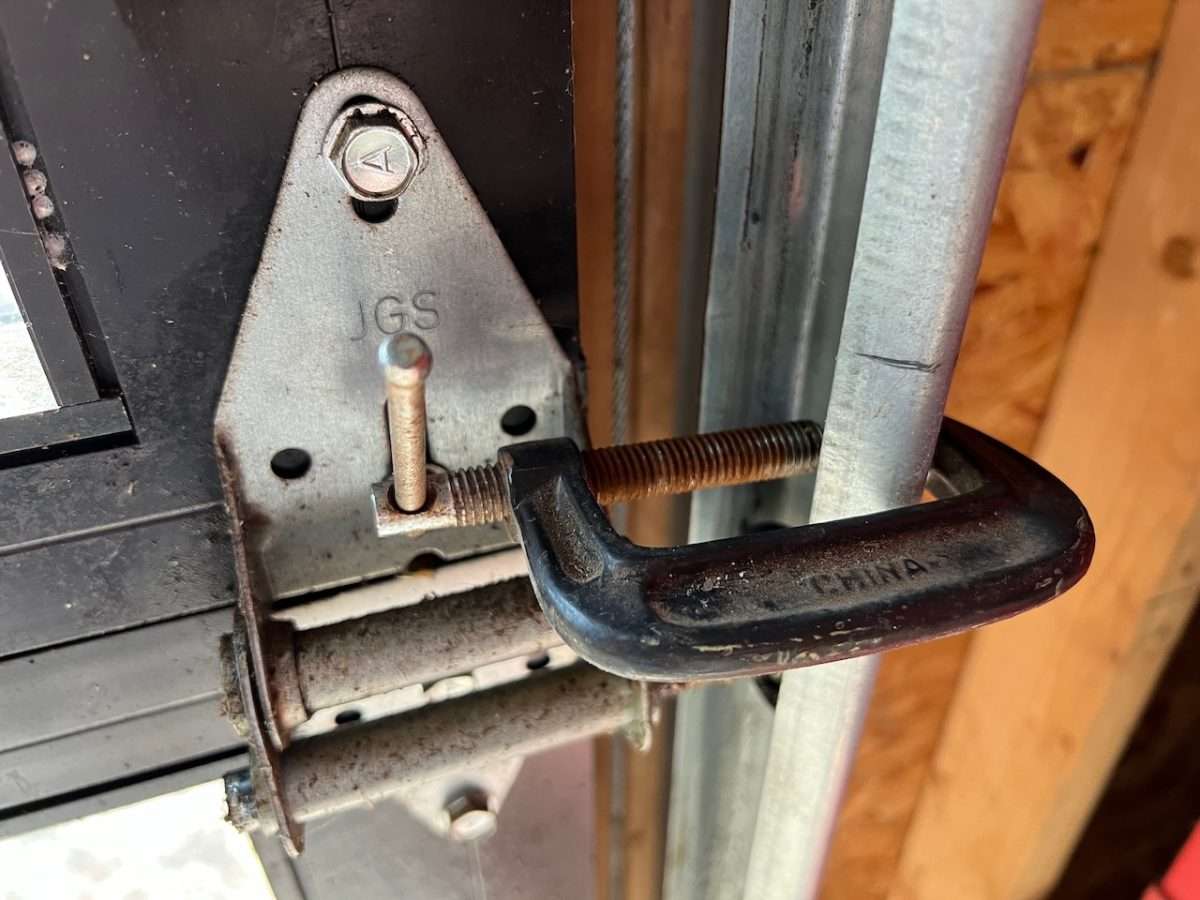
A standard c-clamp mounted right above the garage door roller works well to secure a garage door.
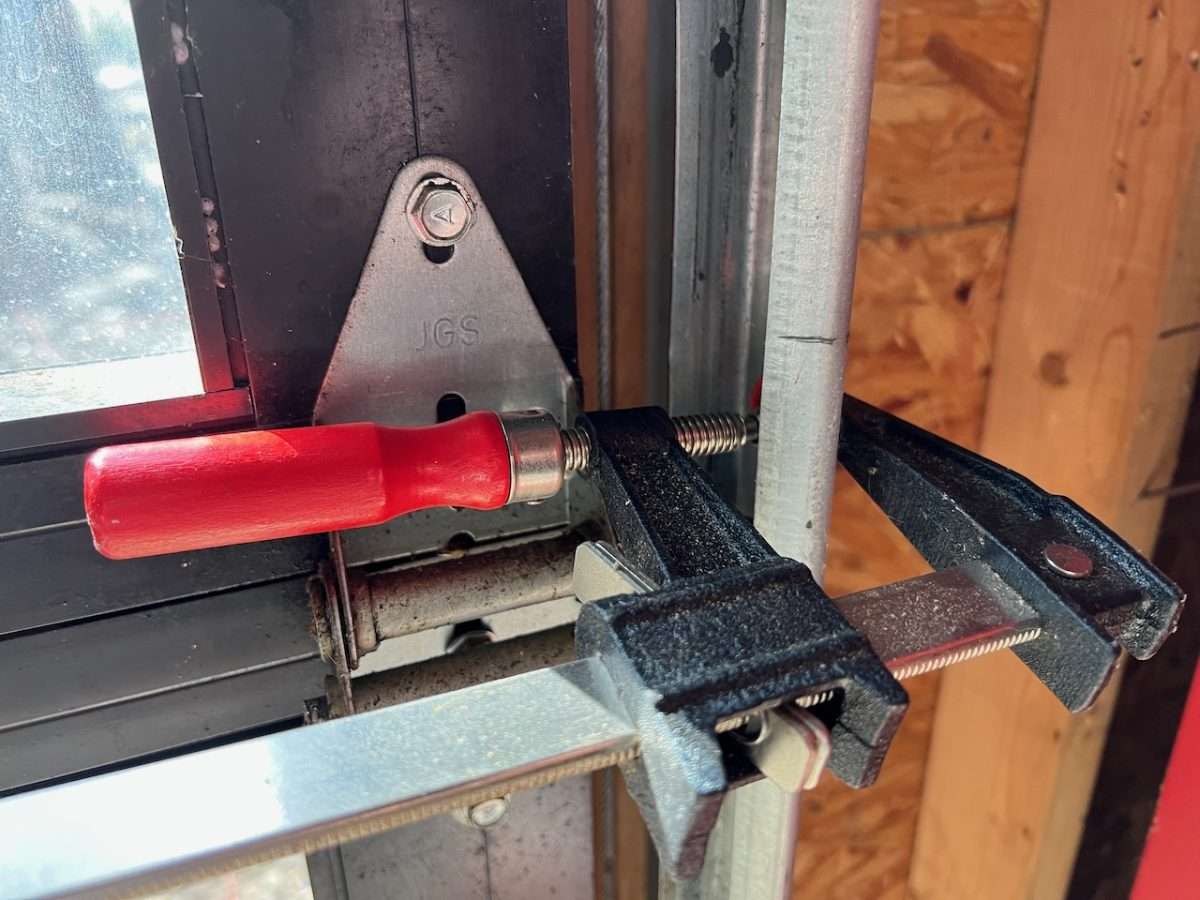
Wood clamps can be used as well, as they serve the same purpose, which is to hold the garage door in the down position so no one can lift it from the outside.
Bolt Installed in Vertical Track
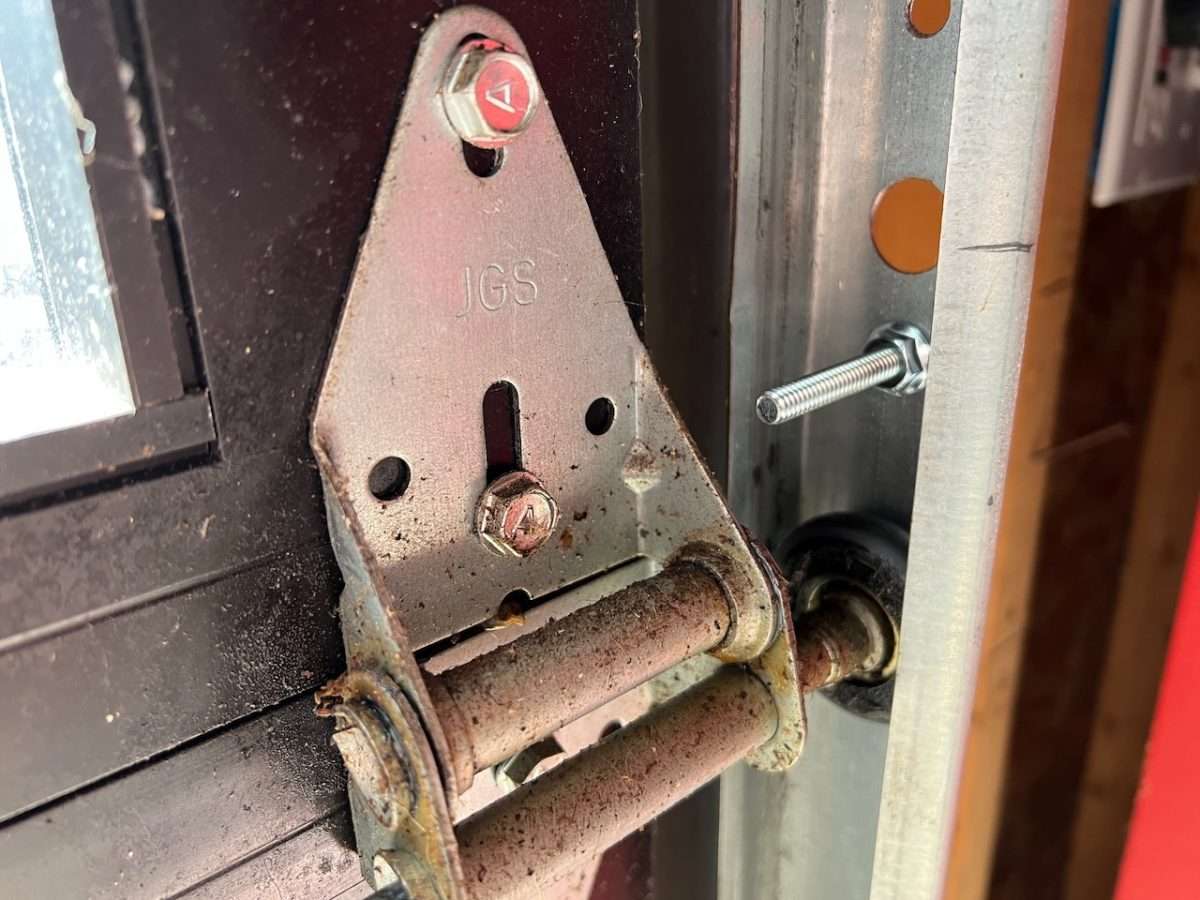
If you have an extra bolt lying around in your garage, you can install it in one of the holes above the garage door roller. Vertical tracks on garage doors have holes in many areas, allowing you to install a bolt that prevents the garage door from being opening.
Alarm Sensor on Garage Door
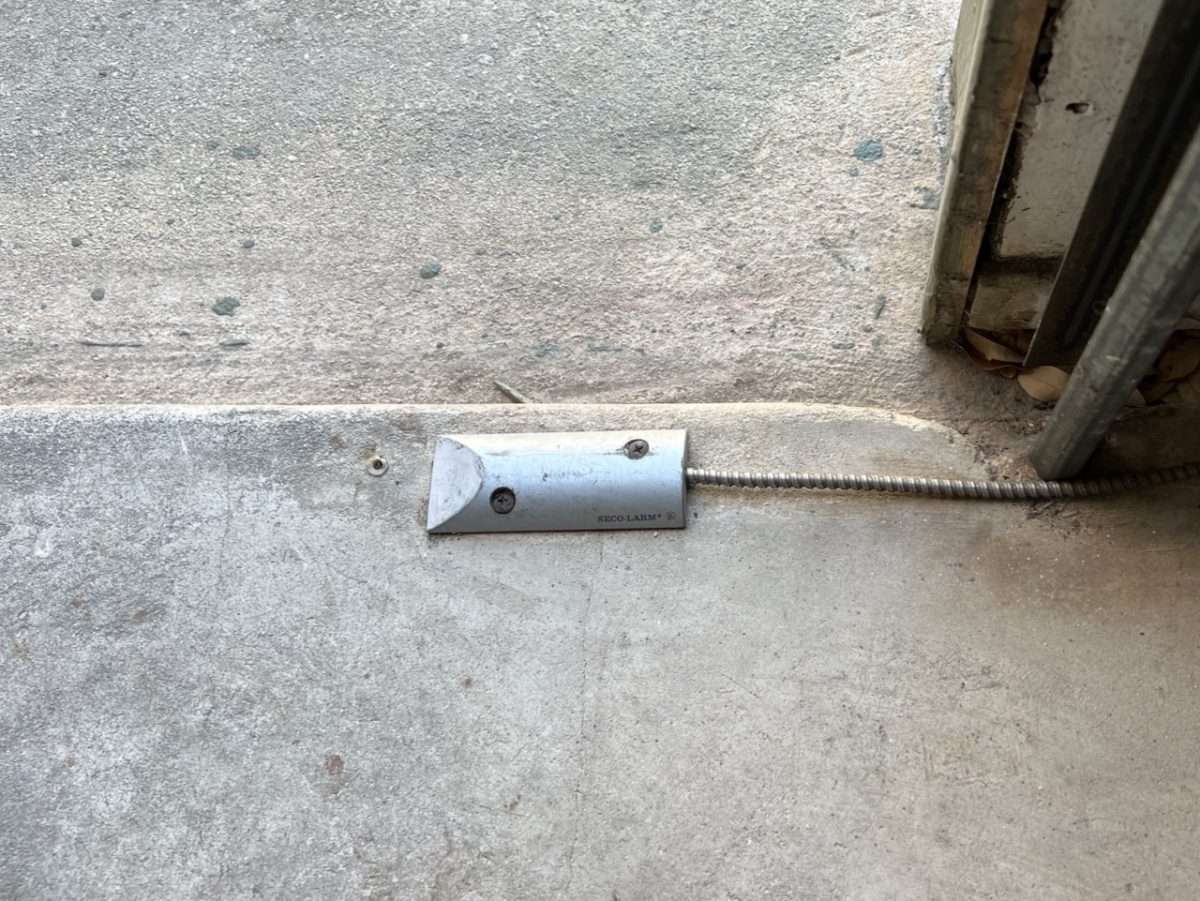
If you are looking for some additional security for your garage door, try contacting your alarm company and requesting sensors to be put on your door. This way, you are alerted in the evening when you activate your alarm whether your garage door is closed. You will also be able to monitor the garage door status from the alarm app on your phone.
IMPORTANT: Disengage Lock or Remove Item Securing Garage Door
Make sure you disengage locks or remove anything you have used to secure your garage door before using your automatic opener. If you forget and run your opener, your garage door will most likely come off track.
Garage Door Opener Security
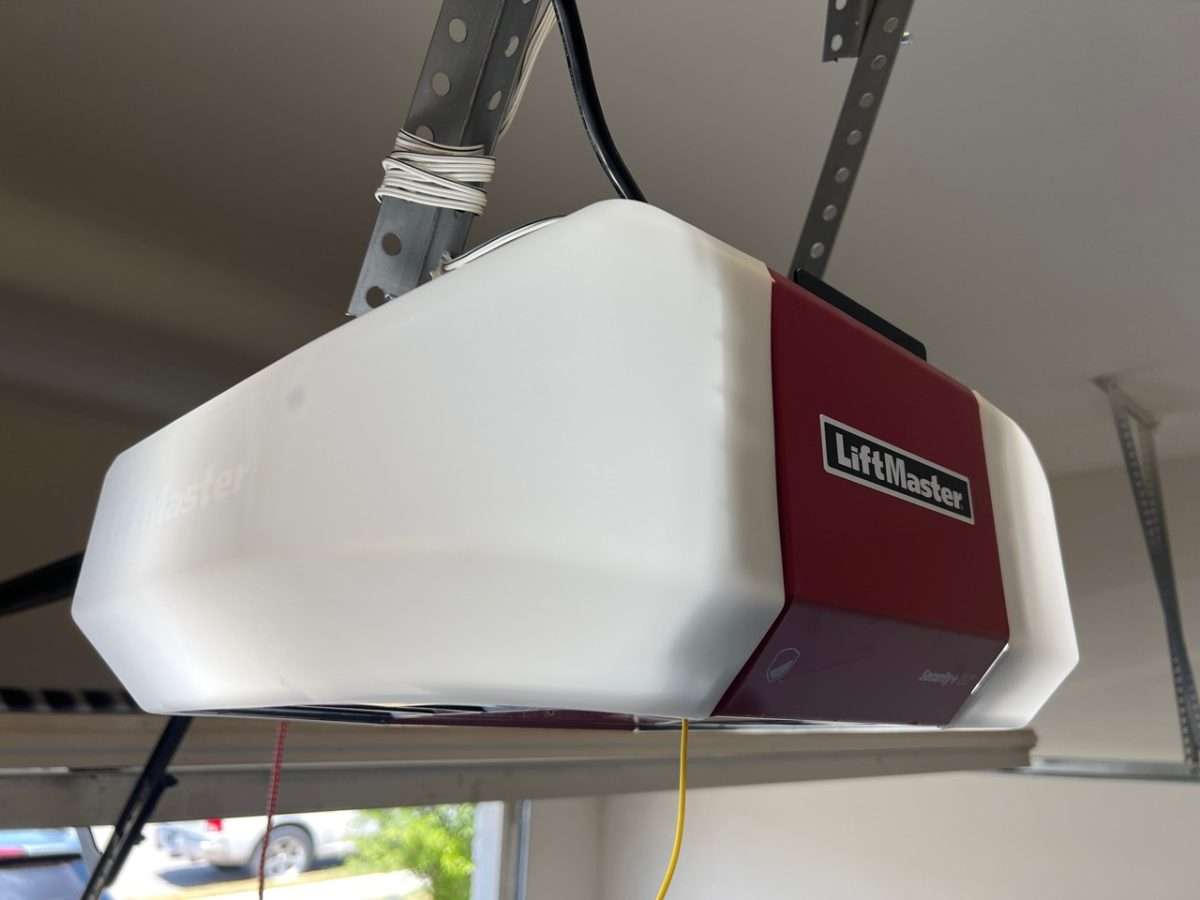
Like we discussed earlier, all newer garage door openers use a rolling code technology to prevent someone from accessing your garage by stealing the remote code. This was a problem that was more common in the past, when frequencies were more simple and garage door openers used 12 DIP switches to set the code for the remotes.
Use a Timer to Close Garage Door Opener
The timer to close feature is available on certain models of garage door openers available today. This is a feature that allows you to set a specific amount of time for the opener to automatically close on its own after your garage door has been opened.
This feature is especially popular with people who forget to close their garage door regularly. If your garage door is always left open, this may be just what you’ve been looking for. Some companies offer third-party accessories that can be added to existing openers.
Unplug Your Garage Door Opener
If you want the ultimate security with your garage door if you are having issues with your automatic opener, unplug the unit. This is most common when a garage door opener is opening on its own. There is no better way to secure your garage door until you can get any issues you are having worked out.
Another great reason to unplug your opener is if you manually lock your garage door when you go out of town. This prevents you from returning home and pressing the wall button to open the garage door while it is locked. Opening a garage door while it’s locked can cause it to go off track or damage the sections.
LiftMaster Security+ 2.0
LiftMaster Security+ 2.0 is their latest technology that sends a new code to your automatic opener with every click. This prevents anyone from getting your code and accessing your garage.
LiftMaster 841LM Automatic Garage Door Lock
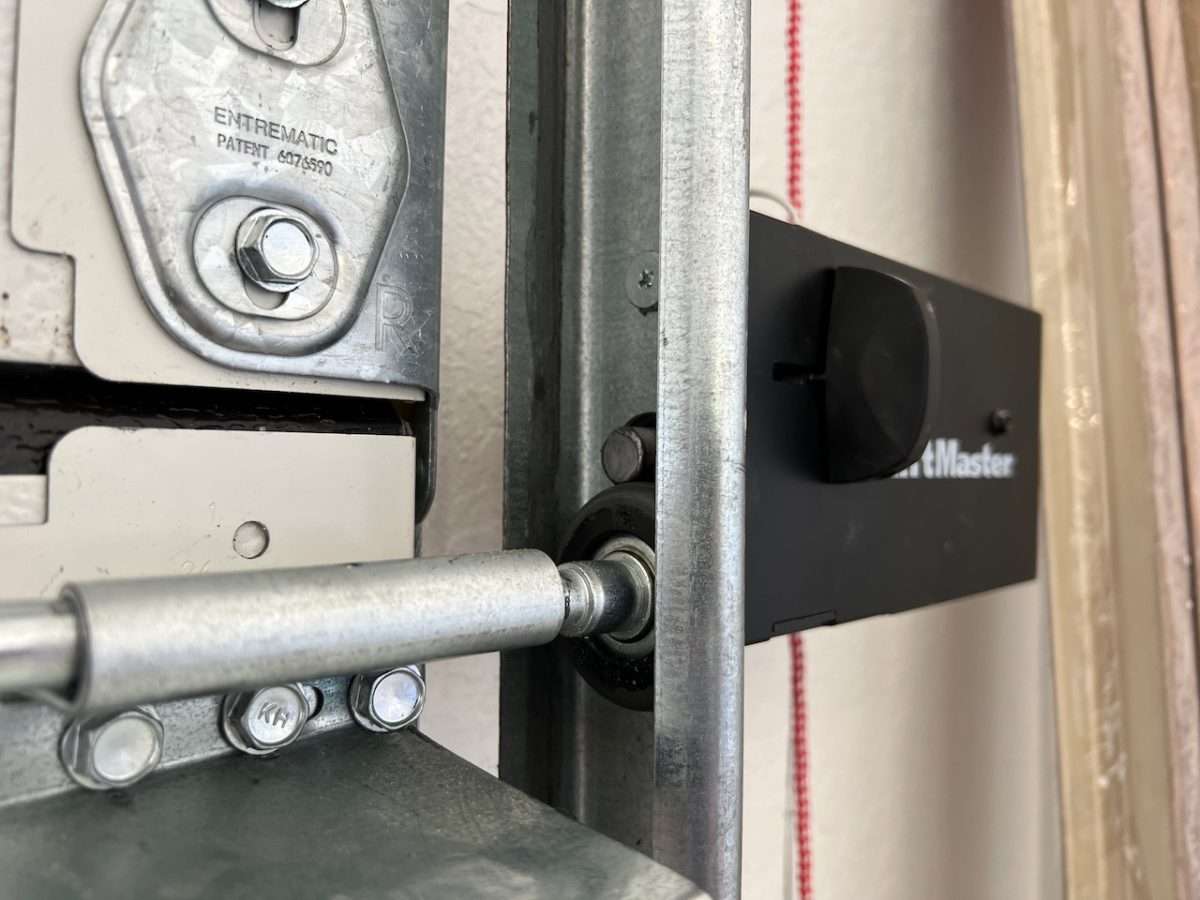
LiftMaster makes an automatic deadbolt garage door lock that mounts to the vertical track on the garage door. The unit is compatible with only a few models of garage door openers that feature the plug in for the harness. The way the 841LM lock works is the unit will engage a deadbolt right above the garage door roller after the door closes.
This adds an extra layer of security by preventing anyone from forcing your garage door open. The 841LM automatic lock comes standard with the LiftMaster 8500W wall mount opener.
Garage Door Window Security
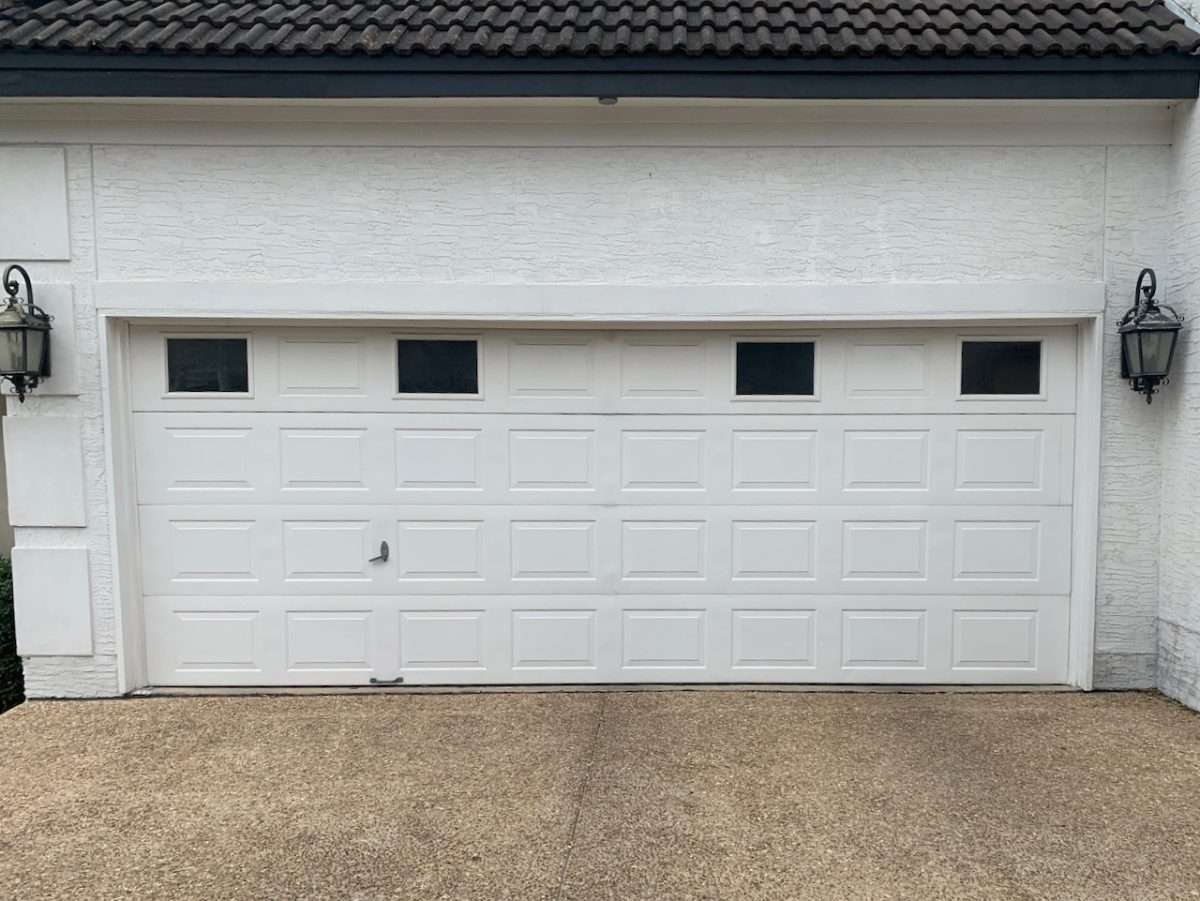
Most security experts will say if you don’t want anyone breaking into your garage, don’t get windows. The easiest way for someone to break into a garage door would be to break a window in the center of the top section and pull the red rope. While it may sound like this frequently happens, it is not that common because of the noise and exposure that most garage doors pose when facing the street.
If having garage door windows all the way across bothers you, try going with something like pictured above, which is having windows installed in slots 1, 3, 6, & 8. This way, the two center slots (4&5) are solid metal, making it harder to reach the red rope if the glass were broken. Another popular option is to put the windows in slots 2, 3, 6, & 7.
Obscure Glass on Garage Door
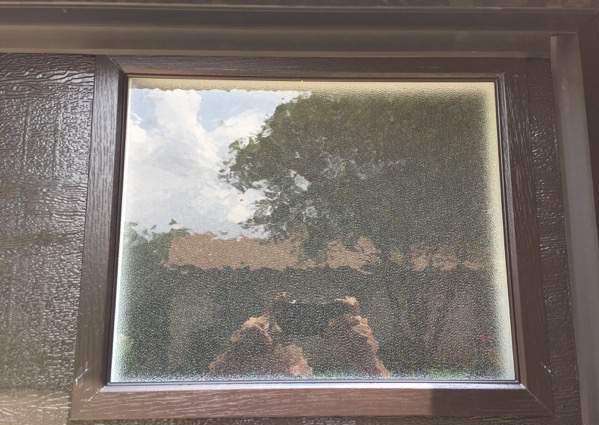
Opting for obscure or frosted glass on your garage door will provide privacy from peeping eyes that may browse into your garage looking for something to steal. These options along with a few others are available on all brands and models of garage doors today.
Tinted Glass on Garage Door
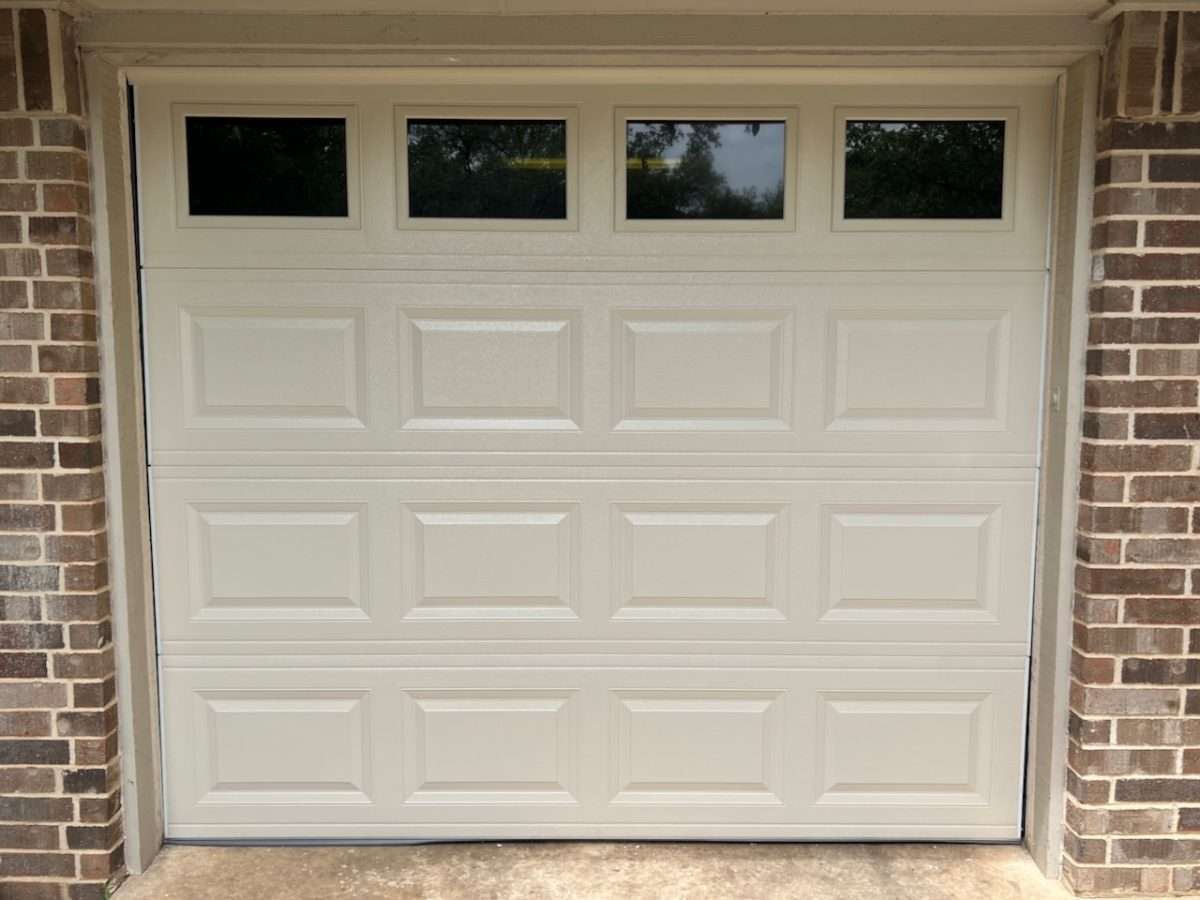
A newer option for glass privacy on garage doors is dark tinted windows. This is something you can order directly from the factory, or you can have it done by a separate company after your garage doors are installed. Either way, it makes it harder to see in the garage, and it has a great look.
Conclusion
There is so much misinformation when it comes to garage door security. Fear has been widely used in marketing and advertising to sell new products to those looking for answers to a problem they don’t have. This simple emotion with fight or flight origins has been abused on the internet, which essentially has left many homeowners with nothing but anxiety.
Security for any home is always top of mind for most people, and the garage door is no exception. Typically, securing the garage door is needed during an emergency where the garage door has come off track or the power has gone out and there is no lock installed on the door. The suggestions in this article will help resolve most issues you may encounter and help ease your mind when it comes to securing your garage door.
